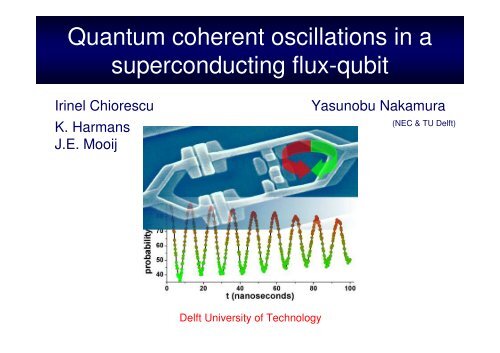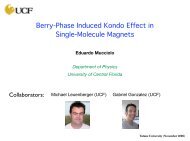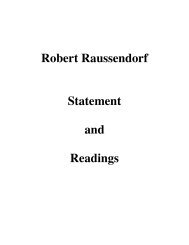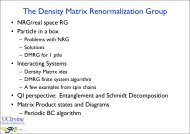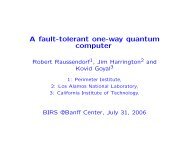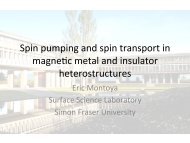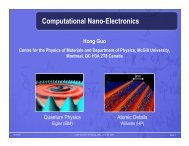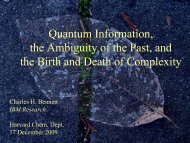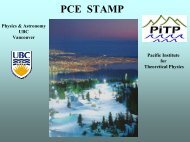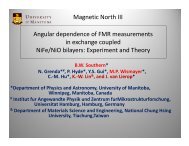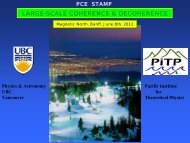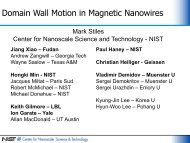Quantum Dynamics of a Superconducting Flux-Qubit
Quantum Dynamics of a Superconducting Flux-Qubit
Quantum Dynamics of a Superconducting Flux-Qubit
You also want an ePaper? Increase the reach of your titles
YUMPU automatically turns print PDFs into web optimized ePapers that Google loves.
<strong>Quantum</strong> coherent oscillations in a<br />
superconducting flux-qubit<br />
Irinel Chiorescu<br />
K. Harmans<br />
J.E. Mooij<br />
Yasunobu Nakamura<br />
(NEC & TU Delft)<br />
Delft University <strong>of</strong> Technology
<strong>Quantum</strong> Transport group<br />
Pr<strong>of</strong>. J.E. Mooij<br />
Kees Harmans<br />
<strong>Flux</strong>-qubit team<br />
visitors<br />
Yasunobu Nakamura (NEC Japan, 2001-2002)<br />
Kouichi Semba (NTT Japan, 2002-2003)<br />
PhD students<br />
Alexander ter Haar<br />
Adrian Lupacu<br />
Jelle Plantenberg<br />
postdocs<br />
Patrice Bertet<br />
Irinel Chiorescu<br />
students<br />
technical staff<br />
collaborations<br />
MIT, TU Delft (theory), U Munich, CEA-Saclay<br />
acknowledgements<br />
FOM (NL) , IST (EU) , ARO (US)
Outline<br />
introduction<br />
initialization, operation, readout<br />
sample<br />
results<br />
conclusion<br />
future plans
3 Josephson-junctions <strong>Quantum</strong> Bit<br />
J.E. Mooij et al, Science, 285, 1036 (1999)<br />
superconducting loop, with 3<br />
Josephson junctions<br />
2 are identical and the 3rd is<br />
smaller (α=0.6 − 0.8)<br />
Josephson Potential:<br />
U=ΣE J<br />
I<br />
u = U/E J<br />
u = 2 + α - cosγ 1 - cosγ 2 - αcos(γ 2 - γ 1 + 2πf)<br />
φ 1 = (γ 1 - γ 2 )/2 , φ 2 = (γ 1 + γ 2 )/2<br />
u = 2(1 - cosφ 1 cosφ 2 ) + 2αsin 2 (φ 1 - πf)
Josephson potential - phase space<br />
2 wells separated by a barrier<br />
for f=0.5, symmetric barrier<br />
α=0.8, f=0.5<br />
T in<br />
T out<br />
T out
Josephson potential - spin space<br />
u = 2 + α - cosγ 1 - cosγ 2 - αcos(γ 2 - γ 1 + 2πf)<br />
u = 2(1 - cosφ 1 cosφ 2 ) + 2αsin 2 (φ 1 - πf)<br />
s x = cosφ 1 cosφ 2 , s y = cosφ 1 sinφ 2 , s z = sin φ 1<br />
u = 2(1 ± s x ) + 2α(1 - s z2 ) +<br />
2α[(1 - 2s z2 )cos 2 πf ± s z √1-s z2 sin(2πf)]
<strong>Flux</strong> <strong>Qubit</strong> – two level system<br />
C. van der Wal et al, Science, 290, 773 (2000)<br />
Exact diagonalisation: two<br />
levels at the bottom <strong>of</strong> the<br />
spectra<br />
Two wells separated by a<br />
barrier<br />
0.5<br />
Persistent currents <strong>of</strong><br />
opposite direction |↑ and |↓<br />
SQUID critical current qubit<br />
→ persistent current<br />
Microwave induced<br />
excitation → level structure<br />
see also, J. Friedman et al, Nature, 406, 43 (2000)
Coherent oscillations<br />
Magnetic resonance with a single, macroscopic quasi-spin<br />
Bloch sphere<br />
|Ψ>=α|↑>+β|↓><br />
Rabi oscillations<br />
microwave excitation with<br />
frequency ω and amplitude A<br />
coherent rotations with Ω Rabi ∝ A<br />
A<br />
MW pulse<br />
ω = ∆E<br />
Ω Rabi ∝ A<br />
|e><br />
|g>
<strong>Qubit</strong> operated at the magic point<br />
|↑<br />
Hamiltonian and eigenstates<br />
|1<br />
H = -ε/2 σ z – ∆/2 σ x<br />
tan2θ = ∆/ ε<br />
|0 = cosθ |↑ + sinθ |↓<br />
|0<br />
|1 = -sinθ |↑ + cosθ |↓ |↓<br />
shift<br />
|↓<br />
|↑<br />
Initialization, ε = 0<br />
|Q = |0 = (|↑ +|↓)/√2<br />
Operation , ε = 0<br />
|Q = α|0 + β|1<br />
Readout , ε > 0<br />
|Q = α|0 + β|1<br />
|Q<br />
|1<br />
|0<br />
MW pulse ON<br />
(rotating frame)<br />
= |α| 2 - |β| 2<br />
|Q<br />
MW pulse OFF<br />
(lab frame)
Switching event measurements<br />
Device<br />
qubit merged with the SQUID<br />
strong coupling L<br />
I pulse<br />
~30ns rise/fall time<br />
shift<br />
t<br />
Readout<br />
bias current to switch the SQUID<br />
ramping generates the shift<br />
(preserving the qubit information)<br />
switching current depends on<br />
qubit state (spin up or down)<br />
pulse height: I sw0 < I b < I sw1<br />
see also the quantronium: Science, 296, 886 (2002)
Automatic shift <strong>of</strong> γ Q and switching<br />
qubit merged with the SQUID<br />
big junctions<br />
strong coupling L<br />
large circulating<br />
currents<br />
bias current generates<br />
a shift in γ qubit<br />
switching occurs far<br />
from degeneracy
Sample<br />
E J<br />
/E C<br />
= 34.65<br />
E C<br />
= 7.36 GHz<br />
α = 0.8<br />
∆ = 3.4 GHz<br />
I p<br />
= 330 nA<br />
large junctions<br />
I c<br />
= 2 µA<br />
strong coupling<br />
L=10 pH<br />
shunt capacitance<br />
C = 10 pF<br />
bias line<br />
R b<br />
= 150 Ω<br />
voltage line<br />
R v<br />
= 1 kΩ
Cavity, wiring
<strong>Qubit</strong> spectroscopy<br />
Energy (GHz)<br />
40<br />
20<br />
0<br />
-20<br />
-40<br />
0.46 0.48 0.50 0.52 0.54<br />
total flux (Φ 0 )<br />
(I sw - I bg ) / I ctr (%)<br />
F (GHz)<br />
2<br />
1<br />
0<br />
15<br />
10<br />
5<br />
0<br />
16 GHz<br />
16 GHz<br />
0.008 π<br />
∆ = 3.4 GHz<br />
-0.005 0.000 0.005<br />
∆Φ ext / Φ 0
artificial + automatic shift<br />
MW line: DC pulse added to the MW pulse (16GHz)<br />
<br />
<br />
DC pulse<br />
<br />
<br />
<br />
<br />
<br />
DC pulse<br />
<br />
0.0316 V<br />
0.585 V<br />
1.202 V<br />
3.8 V<br />
- 0.224 V<br />
- 4.7 V<br />
0.004 π<br />
0.0045 π
Spectroscopy around the ∆ gap<br />
DC shift<br />
16<br />
14<br />
12<br />
F (GHz)<br />
10<br />
8<br />
6<br />
4<br />
2<br />
0<br />
-0.005 0.000 0.005<br />
∆Φ ext / Φ 0
Rabi: pulse scheme<br />
RF line: one microwave pulse with varying length<br />
bias line: Ib pulse<br />
<br />
<br />
<br />
<br />
<br />
<br />
<br />
voltage line: detection <strong>of</strong> the switching pulse
Rabi coherent oscillations<br />
decay time ≈ 150 ns<br />
80<br />
0.6<br />
switching probability (%)<br />
60<br />
40<br />
80<br />
60<br />
40<br />
80<br />
A = 0 dBm<br />
A = -6 dBm<br />
0.5<br />
0.4<br />
0.3<br />
0.2<br />
Rabi frequency (GHz)<br />
60<br />
0.1<br />
F Larmor<br />
= 6.6 GHz<br />
40<br />
A = -12 dBm<br />
0.0<br />
0 10 20 30 40 50 60 70 80 90 100 0.0 0.5 1.0 1.5 2.0<br />
pulse length (ns)<br />
MW amplitude<br />
10^(A/20) (a.u.)<br />
I. Chiorescu, Y. Nakamura, C.J.P.M. Harmans, J.E. Mooij, Science, 299, 1869 (2003)
Fast oscillations<br />
100<br />
90<br />
Psw (%)<br />
90<br />
60<br />
Switching probability (%)<br />
80<br />
70<br />
60<br />
50<br />
40<br />
30<br />
Psw (%)<br />
30<br />
62<br />
60<br />
58<br />
0 10 20 30<br />
RF pulse length (ns)<br />
RF pulse length (ns)<br />
20<br />
500 510 520 530<br />
0 50 100 150 200 250 300 350 400 450 500<br />
RF pulse length (ns)
Towards single-shot resolution<br />
100<br />
80<br />
F=6.512 GHz<br />
A=-3 dBm<br />
switching probability (%)<br />
60<br />
40<br />
20<br />
0<br />
N- number <strong>of</strong> averaged events<br />
N=1<br />
N=10<br />
N=10000<br />
0 10 20 30 40 50 60 70 80<br />
RF pulse length (ns)
Ramsey interference<br />
Ramsey: two π/2 pulses with varying time in between<br />
<br />
π<br />
<br />
<br />
π
Ramsey fringes<br />
0 MHz<br />
F L<br />
= 5.61 GHz<br />
detuning<br />
P SW<br />
(%)<br />
90<br />
60<br />
30<br />
0 5 10 15 20 25 30<br />
time between two π/2 pulses (ns)<br />
310 MHz
Ramsey interference<br />
Ramsey: decoherence time T 2* ≈ 20 ns<br />
80<br />
P SW (%)<br />
70<br />
60<br />
50<br />
π/2 π/2<br />
0 5 10 15 20 25 30<br />
π/2<br />
distance between two π/2 pulses (ns)<br />
F L<br />
= 5.7 GHz, dF= 220 MHz, TRamsey: 4.5 ns
Spin-echo experiments<br />
spin-echo: two π/2 pulses and one π pulse in between<br />
with varying position<br />
<br />
π<br />
π<br />
π<br />
<br />
<br />
<br />
<br />
switching probability (%)<br />
70<br />
60<br />
50<br />
π/2<br />
π π/2<br />
-25 -20 -15 -10 -5 0 5 10 15 20 25<br />
position <strong>of</strong> π pulse (ns)<br />
F L = 5.7 GHz, dF= 220 MHz, TRamsey: 4.5 ns, Tspin-echo: 2.3 ns
Signal decay in spin-echo<br />
switching probability (%)<br />
60<br />
50<br />
40<br />
30<br />
20<br />
10<br />
0<br />
Detuning<br />
F res<br />
= 5.64 GHz<br />
50MHz<br />
100MHz<br />
200MHz<br />
F Rabi<br />
= 297.6 MHz<br />
0 20 40 60 80 100<br />
distance between two π/2 pulses (ns)<br />
spin-echo: max signal decay time T 2 ≈ 30 ns
Relaxation measurements<br />
one π pulse and read-out pulse delayed<br />
<br />
π<br />
<br />
<br />
<br />
<br />
<br />
100<br />
switching probability (%)<br />
90<br />
80<br />
70<br />
60<br />
50<br />
40<br />
30<br />
0 1 2 3 4 5 6 7 8 9 10<br />
delay time (µs)<br />
8.3 ns, A=-12dBm<br />
6 ns, A=-9dBm<br />
4.5 ns, A=-6dBm<br />
3.2 ns, A=-3dBm<br />
2.445 ns, A=0 dBm<br />
exp fit <strong>of</strong> A=-12dBm<br />
T 1<br />
= 870 ns
Conclusion<br />
we demonstrate coherent quantum<br />
oscillations in a superconducting flux-qubit<br />
spectroscopy<br />
relaxation time ≈ 1 µs<br />
Rabi oscillations with decay time ≈ 150 ns<br />
Ramsey interference: decoherence time ≈ 20 ns<br />
spin-echo experiment: decay time ≈ 30 ns


